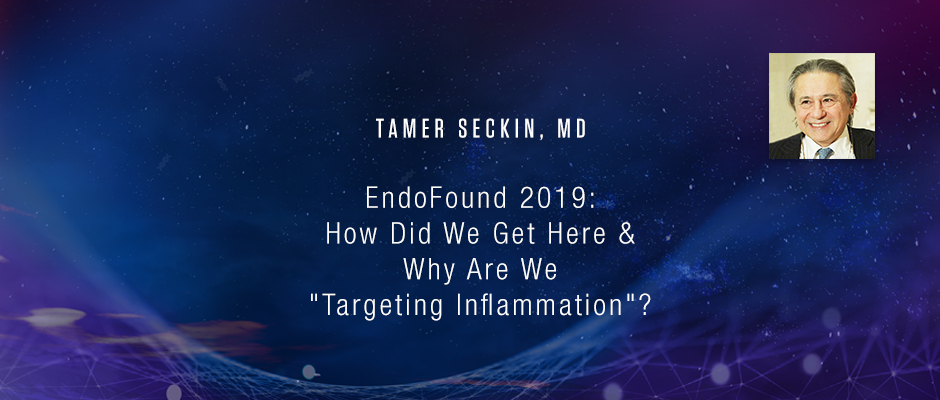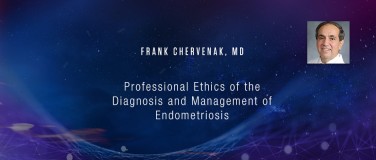Tamer Seckin, MD
Opening and Welcome
EndoFound 2019: How Did We Get Here & Why Are We "Targeting Inflammation"?
Endometriosis Foundation of America
Medical Conference 2019
Targeting Inflammation:
From Biomarkers to Precision Surgery
March 8-9, 2019 - Lenox Hill Hospital, NYC
Very warm good morning. Welcome to Lennoxville Hospital to 10th year anniversary of our foundation. I cannot express my gratitude you all made here. We feel very special. We have legendary surgeons, very distinguished researchers, department chiefs, people who have given their lives to this disease. It's a very challenging disease, very difficult disease, very complicated disease, and it really hasn't changed for the last hundred years it was defined.
The foundation was originally established in 2006, and I was joined by Ms. Lakshmi, 2009. We co-mothered her as a face, and she graciously accepted it, and she gave us an incredible lift through our yearly balls and meetings.
So, we are ... the mission of the foundation is we strive to increase disease recognition. We have been targeted ... the topic is targeting inflammation. We have targeted inflammation 10 years ago. Since then, we haven't missed our target. Every year we talk about the same topic in a different way. Well 10 years ago it was ... for so many it wasn't known, but it was about stem cells. Stem cells are the quarterback of all the inflammatory process. The cascade of inflammation that ignites the fibrosis, scarring, deep nodules, all the way to the frozen pelvis. Every scene there is inflammation.
Inflammation is the ignorance of what we don't know. It represents everything that is a dilemma about endometriosis, from patients, from the etymology, from the patient's every suffering that is described with pain, anguish, tiredness, bloated-ness, gas, bowel symptoms, leg pain, you name it. It's all, all inflammation. Yet, the word inflammation finds itself very rarely in our language of describing endometriosis. We classically describe it's the tissue that's found elsewhere, the period tissue in the outside uterus, yet the real pathology is the inflammation.
So we continued to do these meetings. We talked about sex seriously. Again we tapped the roots. We talked about the early diagnosis, early intervention, and we were always on the same top deck.
The foundation has done great stuff. First of all, I'm proud to announce we have almost educated 35000 young girls and boys in New York State. We taught them what endometriosis and reproductive health and menstrual health were about. 35000, one to one, didactic teaching in classrooms. This was a huge effort for us, and we are proud to announce we are going to bring this program nationally.
We gave away for this year, 250000. We will be giving away more than 1 million dollars for research. If you think of ... NIH is giving 11 million dollars for endometriosis research. Well for a humble small charity like us to give 1 million dollars over four years is significant progress. I thank the generous contributors from San Francisco to New York. These were all individuals.
And we also, through this effort we published a paper with John Hopkins Doctor Shih and Doctor Ayhan is here. This article was published in the New England Journal of Medicine, Cancer-Associated Mutations in Endometriosis without Cancer. It was selected as the most original article of 2017 and again picked up by the prestigious bosses in pathology group. Again the most influential article of that year.
Again, thank Padma for standing by me, with us. Lena Dunham, Susan Sarandon has given their humble faces for this disease.
Well, it does take a team to do it, and this team is international, and yet ... this is a meeting from South Africa, from approximately 20 years ago. Ray Gary is here. Unfortunately, Johann, we lost to pancreatic cancer. He was the most fun man who gave us incredible lectures and tours, everything about South Africa. It's hard to not remember [Kutsam 00:05:21] and Harry. This is a meeting from 1996 from Belgium, which I met many important people through Harry. As you know, Harry's influence on laparoscopy and the way he changed history the way we practice, I don't think anybody had as much influence on the way people practice laparoscopic surgery with respect to deep excisions and brave surgeries he has demonstrated throughout the world.
Again, 100 years later, we will talk a lot about Samson, and Samson 100 years ago talk about inflammation, talk about the rupture of endometrioma Adhesions Cul de sac disease. We're still talking about the same thing, and at those years there was another man, Cullen. He was a ... oncologist. He said endometriosis surgery is the most difficult surgery. It's even much difficult than Wertheim Hysterectomy, and we know he's right, and it still is.
So, there comes Dr. Redwine. He's the man with incredible wit and I have great respect the way he describes things, and he really lead the way of the early legions, how it is described, and near contact examination of the peritoneum, and I think Redwine's place is very special in our field, and I'm privileged to have him here, as well as Ray Gary which we mentioned.
There comes Dr. Martin. He is the man who documents everything. Nothing will escape his eye. He will review the history and hopefully will ... battle Redwine's opinion and his way in the next few days as to how endometriosis originates.
And that is my humble technique of looking at tissues. I learned, I someone ... in a way it came back naturally as I see other people doing it, thus creating contrast behind the peritoneum is an incredible technique which I find very useful, and Bruce [Leslie 00:07:38] has done similar work on using blue dye, and I looked at the literature. Believe it or not, eye surgeons are using the same technique to demonstrate the legions and conjunctival lining for optic nerve observation. They inject blue dye behind the conjunctival to find the areas that involve the pathology and conjunct that they can not see.
The reason is bright light obliviates our vision and when you create a contrast behind, the layer comes and the whiteness and the pathology show up.
So this is all the small figure of how things go to the frozen pelvis, and the molecules and all the things that there will be researcher will be talking about these all day.
So this is an interesting vaginoscopy with water. You see the cervix is bleeding. This disease involved from cervix all the way to the diaphragm and these vaginal ..., you see this is all endometriosis in the posterior fornix.
The disease involves every organ as you see in this case. The ... is obstructed, there's ... on the right side. Okay. So doesn't want to play. Let's see. Whoops.
So, there you see a patient with bilateral hydro nephroses with nephroscopy tubes. Does anybody know what this is? Maybe whoever in my conference may see, I show this all the time. Any guesses? [Stant 00:09:30]. Rectal Stant. Do you see patients like this?
How about this?... dislocation. Patient has had two pins there, yet she has sciatica, very advanced endometriosis into sciatic nerve. The same patient as you see, there's a nodule here. She has an [arquate 00:09:55] uterus.
Another patient, we just saw this patient two weeks ago. She came from Florida. She's got pins on, again, on two sides, advanced endometriosis, cannot move her legs, has been operated multiple times with these pins and pins are replaced. Now the orthopedic surgeons are in the scene. They are doing labral tear repairs, hip replacement on under patients and these are the pins. This is what I'm seeing. God knows what else is happening out there.
So disease can involve every organ from rectum to bladder, and ureter, we cut these, we can ... I mean we really require a good team to do these. I'm lucky to have very good assistance and help from my urology team and general surgery team. We can do all these procedures. Diaphragm, frequently involved in endometriosis cases, yet less diagnosed. This is a hole, we were using mesh in the past. Now we stitch either from below or from above. We use stables or we excise the tissues for error.
This is a patient we operated just recently, two weeks ago. She came through the emergency room. We had to operate her before. We missed this legion on the dome. We thought we were done. As we looked at the other part of the dome with the third-degree angle we saw this legion. Obviously, the layer is so thin we can see the other side. We do a laparoscopic, thoracoscopy here, and this was also stitched from below. And believe it or not, I'm lucky to work with a thoracic surgeon that allows us to stitch, and we do manage the cases together.
So, diaphragm legions are commonly seen in our hospital. We probably did more than 25 cases in the last two years like this.
So I don't know how the time is going. It's 8:30 already, but overall, it's difficult to tell all the story about endometriosis and to explain to you the techniques, but it's important to value what really happens in the pelvis. This is true retrograde blood coming, but that doesn't explain everything. However, it's the most proximal and reasonable triggering mechanism probably that starts the whole inflammatory process.
This is reflux menstruation, but this is a little cottage, the fifth day of the period, I basically sucked this clot out and sent to pathology. Look at this. This is exactly what I pulled out. Clot, and glands. The gland is there. No one can deny that. And this is a little mouse. This belongs 15 years ago. I can never throw this little video away, but you can see that little thing is really floating. As I push the fluid it floats, but with vessels, it's tied to the ... under the ... See it's moving. I call this my little mouse.
So this is a little animation, again, I did 15 years ago. I still go back to this animation. It tells me a lot of things, how this peritoneum gets battered with repeated periods. Almost it gets marinated for a fake endometrium, for the fake process starts, and the role of stem cells, both the ones that come from the endometrium and the one that sprouts from the subperitoneal, there is this re-oxygenation of the debris. It's not that simple. The disease also starts with ... more of the retrograde-ness, and peritoneum we develop these pseudo sacks. You can really imagine how the period can get trapped to these things. As you can see there is more legion on the right-hand side, deeply located on this right-hand side, which you cannot appreciate unless you explore and remove it, and you see all these markings of the retrograde-ness. These are beautiful ...
This is another version of how you can really look. The disease really sprouts out from the peritoneum. It's really not maybe just coming, implanting like any seed, but this is coming out, sprouting out, as the androgenesis, neuro androgenesis, this little thing explains all the cascades why the nerves are involved. We're lucky to have Dr. Mark Passover. He's going to really give us the picture of the complete nerve damages that goes to paralysis. We can't wait for that presentation.
Look these are, again, the pictures that I love to take during the cases, and these things do bleed. This is the androgenesis that happens. I have so much of these things I can show. For the sake of time, I will cut here. I will stick to the program.









